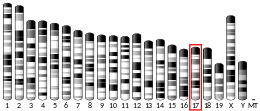Guanylyl cyclase-activating protein 1 is an enzyme that in humans is encoded by the GUCA1A gene .[ 4] [ 5]
LOC118142757 Identifiers Aliases GUCA1A External IDs OMIM : 600364 ; MGI : 1922712 ; HomoloGene : 129540 ; GeneCards : GUCA1A ; OMA :GUCA1A - orthologs Wikidata
^ a b c GRCm38: Ensembl release 89: ENSMUSG00000047150 – Ensembl , May 2017^ "Human PubMed Reference:" . National Center for Biotechnology Information, U.S. National Library of Medicine .^ "Mouse PubMed Reference:" . National Center for Biotechnology Information, U.S. National Library of Medicine .^ Payne AM, Downes SM, Bessant DA, Taylor R, Holder GE, Warren MJ, Bird AC, Bhattacharya SS (Mar 1998). "A mutation in guanylate cyclase activator 1A (GUCA1A) in an autosomal dominant cone dystrophy pedigree mapping to a new locus on chromosome 6p21.1". Hum Mol Genet . 7 (2): 273– 7. doi :10.1093/hmg/7.2.273 . PMID 9425234 . ^ "Entrez Gene: GUCA1A guanylate cyclase activator 1A (retina)" .
Subbaraya I, Ruiz CC, Helekar BS, et al. (1995). "Molecular characterization of human and mouse photoreceptor guanylate cyclase-activating protein (GCAP) and chromosomal localization of the human gene" . J. Biol. Chem . 269 (49): 31080– 9. doi :10.1016/S0021-9258(18)47393-0 PMID 7983048 . Surguchov A, Bronson JD, Banerjee P, et al. (1997). "The human GCAP1 and GCAP2 genes are arranged in a tail-to-tail array on the short arm of chromosome 6 (p21.1)" . Genomics . 39 (3): 312– 22. doi :10.1006/geno.1996.4513 PMID 9119368 . Dizhoor AM, Boikov SG, Olshevskaya EV (1998). "Constitutive activation of photoreceptor guanylate cyclase by Y99C mutant of GCAP-1. Possible role in causing human autosomal dominant cone degeneration" . J. Biol. Chem . 273 (28): 17311– 4. doi :10.1074/jbc.273.28.17311 PMID 9651312 . Sokal I, Li N, Surgucheva I, et al. (1998). "GCAP1 (Y99C) mutant is constitutively active in autosomal dominant cone dystrophy" . Mol. Cell . 2 (1): 129– 33. doi :10.1016/S1097-2765(00)80121-5 PMID 9702199 . Sokal I, Li N, Verlinde CL, et al. (2001). "Ca(2+)-binding proteins in the retina: from discovery to etiology of human disease(1)" . Biochim. Biophys. Acta . 1498 (2– 3): 233– 51. doi :10.1016/S0167-4889(00)00099-9 PMID 11108966 . Downes SM, Holder GE, Fitzke FW, et al. (2001). "Autosomal dominant cone and cone-rod dystrophy with mutations in the guanylate cyclase activator 1A gene-encoding guanylate cyclase activating protein-1" . Arch. Ophthalmol . 119 (1): 96– 105. doi :10.1001/archopht.119.11.1667 PMID 11146732 . Wilkie SE, Li Y, Deery EC, et al. (2001). "Identification and functional consequences of a new mutation (E155G) in the gene for GCAP1 that causes autosomal dominant cone dystrophy" . Am. J. Hum. Genet . 69 (3): 471– 80. doi :10.1086/323265 . PMC 1235478 PMID 11484154 . Hwang JY, Koch KW (2002). "Calcium- and myristoyl-dependent properties of guanylate cyclase-activating protein-1 and protein-2". Biochemistry . 41 (43): 13021– 8. doi :10.1021/bi026618y . PMID 12390029 . Hwang JY, Koch KW (2002). "The myristoylation of the neuronal Ca2+ -sensors guanylate cyclase-activating protein 1 and 2". Biochim. Biophys. Acta . 1600 (1– 2): 111– 7. doi :10.1016/S1570-9639(02)00451-X . PMID 12445466 . Strausberg RL, Feingold EA, Grouse LH, et al. (2003). "Generation and initial analysis of more than 15,000 full-length human and mouse cDNA sequences" . Proc. Natl. Acad. Sci. U.S.A . 99 (26): 16899– 903. Bibcode :2002PNAS...9916899M . doi :10.1073/pnas.242603899 PMC 139241 PMID 12477932 . Pennesi ME, Howes KA, Baehr W, Wu SM (2003). "Guanylate cyclase-activating protein (GCAP) 1 rescues cone recovery kinetics in GCAP1/GCAP2 knockout mice" . Proc. Natl. Acad. Sci. U.S.A . 100 (11): 6783– 8. Bibcode :2003PNAS..100.6783P . doi :10.1073/pnas.1130102100 PMC 164524 PMID 12732716 . Mungall AJ, Palmer SA, Sims SK, et al. (2003). "The DNA sequence and analysis of human chromosome 6" . Nature . 425 (6960): 805– 11. Bibcode :2003Natur.425..805M . doi :10.1038/nature02055 PMID 14574404 . Gerhard DS, Wagner L, Feingold EA, et al. (2004). "The status, quality, and expansion of the NIH full-length cDNA project: the Mammalian Gene Collection (MGC)" . Genome Res . 14 (10B): 2121– 7. doi :10.1101/gr.2596504 . PMC 528928 PMID 15489334 . Peshenko IV, Moiseyev GP, Olshevskaya EV, Dizhoor AM (2004). "Factors that determine Ca2+ sensitivity of photoreceptor guanylyl cyclase. Kinetic analysis of the interaction between the Ca2+-bound and the Ca2+-free guanylyl cyclase activating proteins (GCAPs) and recombinant photoreceptor guanylyl cyclase 1 (RetGC-1)". Biochemistry . 43 (43): 13796– 804. doi :10.1021/bi048943m . PMID 15504042 . Nishiguchi KM, Sokal I, Yang L, et al. (2004). "A novel mutation (I143NT) in guanylate cyclase-activating protein 1 (GCAP1) associated with autosomal dominant cone degeneration" . Invest. Ophthalmol. Vis. Sci . 45 (11): 3863– 70. doi :10.1167/iovs.04-0590 . PMC 1475955 PMID 15505030 . Jiang L, Katz BJ, Yang Z, et al. (2005). "Autosomal dominant cone dystrophy caused by a novel mutation in the GCAP1 gene (GUCA1A)". Mol. Vis . 11 : 143– 51. PMID 15735604 . Sokal I, Dupps WJ, Grassi MA, et al. (2005). "A novel GCAP1 missense mutation (L151F) in a large family with autosomal dominant cone-rod dystrophy (adCORD)" . Invest. Ophthalmol. Vis. Sci . 46 (4): 1124– 32. doi :10.1167/iovs.04-1431 . PMC 1352313 PMID 15790869 . Michaelides M, Wilkie SE, Jenkins S, et al. (2005). "Mutation in the gene GUCA1A, encoding guanylate cyclase-activating protein 1, causes cone, cone-rod, and macular dystrophy". Ophthalmology . 112 (8): 1442– 7. doi :10.1016/j.ophtha.2005.02.024 . PMID 15953638 .



